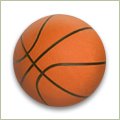
In articles from the most recent issue of the Journal of Athletic Training , researchers examining 15 years of college basketball injury data found that pre-season practice injury rates were about 2 and 1/2 times higher than in-season practice rates.
As the authors comment, this may be due to the fact that pre-season practices are physically more intense, focusing more on conditioning while in-season practices focus more on strategy and game preparation.
However, another potential reason is that players may (unfortunately) not be in shape at the start of pre-season, thinking that this is the time to "get their legs and wind back". In the unprepared player, untreated muscle imbalances, decreased strength, lower cardiovascular conditioning and endurance, and other deficiencies likely increase their risk for a pre-season practice injury.
So what are you waiting for? Don't just get ready for the season by going to the gym to shoot or play in a pick up game. Get a thorough pre-season evaluation now from a physician, physical therapist, athletic trainer, or certified strength and conditioning coach, finish rehabbing any existing injuries, work on neuromuscular training programs to prevent future injuries, work on strengthening your core as well as your arms and legs, and ramp up your cardiovascular conditioning program.
This will increase your chance of becoming a starter, while decreasing your chance for a pre-season injury.












